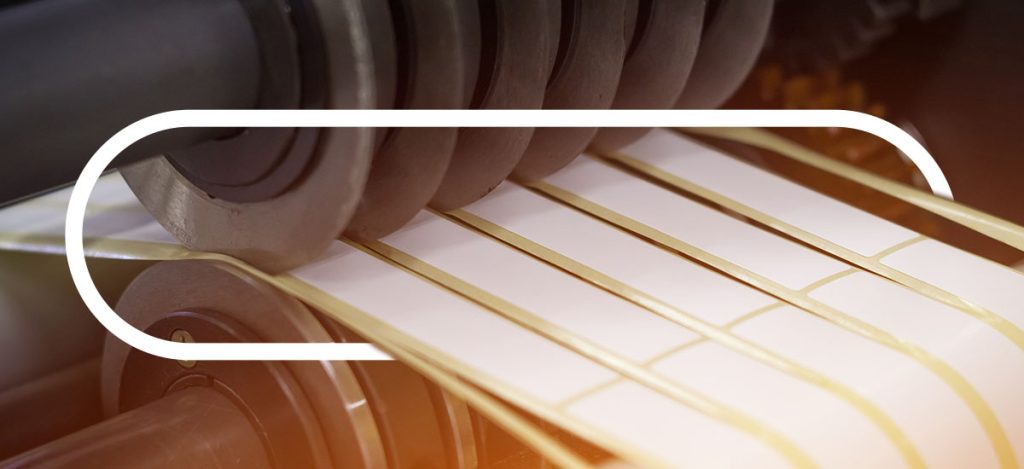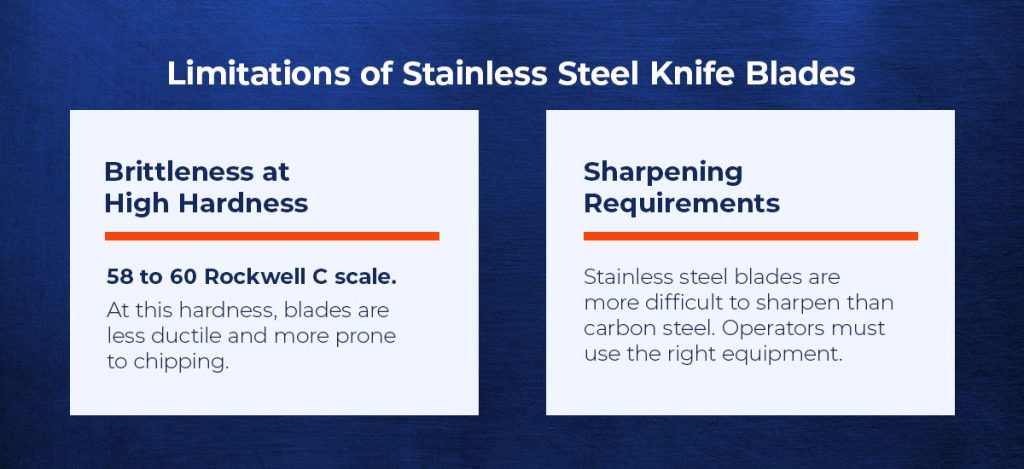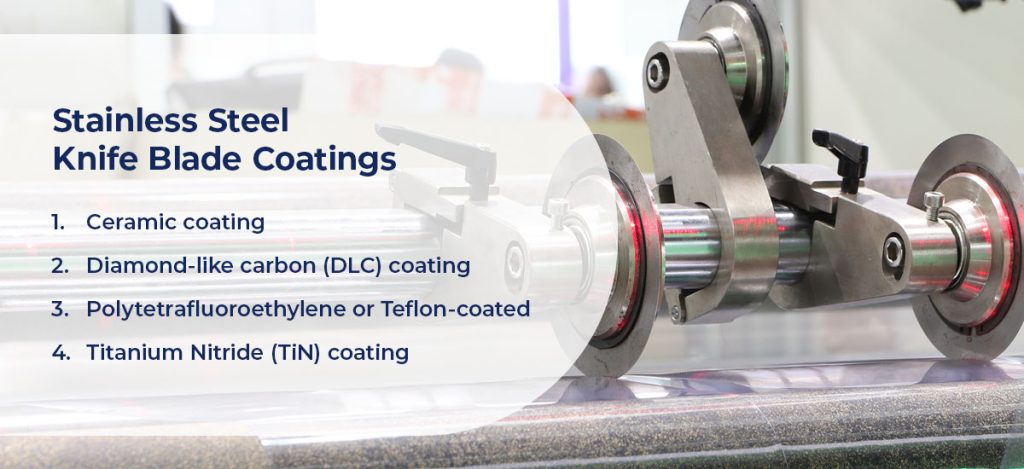
Blade performance affects industrial operations. Every cut impacts yield, product quality and uptime. Stainless steel is a strong material because it withstands wear, resists corrosion and maintains its form under pressure.
However, not all stainless steels are the same. Discover everything you need to know about stainless steel knives below.
What Is Stainless Steel?
Stainless steel is an iron-based alloy containing at least 10.5% chromium by mass. The chromium reacts with oxygen to form a chromium oxide film, which prevents oxidation and provides corrosion resistance.
What Elements Make up a Stainless Steel Knife Blade?
Stainless steel is made up of various alloying elements that contribute to its rust and chemical damage resistance. Here are some stainless steel knife blade forming materials:
- Boron increases the hardenability of steel during heat treatment.
- Carbon determines how hard a blade can become after heat treatment. However, as strength increases, the toughness can decrease.
- Chromium forms a corrosion-resistant layer. The element is a carbide-building agent, contributing to wear resistance.
- Cobalt improves performance at high temperatures and preserves hardness under load.
- Copper is not a primary component in all knife steels, but it contributes to corrosion resistance.
- Manganese supports grain structures and hardening.
- Molybdenum adds strength and prevents brittleness.
- Nickel increases toughness and ductility.
- Phosphorus can strengthen steel in low quantities, but it must be controlled because too much can make a blade brittle.
- Silicon strengthens the steel matrix and improves oxidation resistance.
- Sulfur is usually considered an impurity, but it may be added to improve workability.
- Titanium stabilizes grain size growth, contributing to toughness.
- Tungsten boosts hot hardness and wear resistance by forming stable carbides that retain their toughness at high operating temperatures.
- Vanadium refines the steel’s grain structure, making the blade stronger. It also forms vanadium carbides — particles that increase wear resistance.
Uses of a Stainless Steel Knife Blade
Stainless steel is used in various applications because it supports product quality and efficiency. Here are industrial uses of the material.
Slitting
Slitting involves cutting large rolls of material into narrower strips. It’s a fast-paced, continuous process where edge quality and dimensional accuracy matter. Stainless steel blades are ideal for slitting because they withstand high-speed stress operation without degrading. Their hardness and wear resistance support tight tolerances and clean edges.
Stainless steel’s corrosion resistance is valuable in slitting lines that handle materials sensitive to contamination. This capability supports product integrity and compliance.
Converting
Converting encompasses cutting, slitting and shaping materials for end use. The requirements for converting depend on the substrate and process, but they often involve frequent contact with adhesives, coatings or inks that can compromise untreated steels.
Stainless steel’s nonreactive surface helps minimize buildup and simplifies cleaning during changeovers. Its versatility also allows converters to use the same grade of blade across multiple material types.
Characteristics of a Stainless Steel Knife Blade

Blade material affects cut quality, uptime and maintenance frequency. Stainless steel is a good knife material because it contains qualities that make it well-suited for precision cutting settings. Here are the main characteristics of the blade:
- Corrosion resistance: The chromium layer protects against oxidation when exposed to moisture, adhesives or process chemicals. This resistance prevents rust, pitting and edge degradation, supporting cleaner slits and less contamination.
- Durability and strength: Stainless steel grades like 440C can be hardened to resist wear, while still withstanding the repeated mechanical stress of converting lines. This durability reduces premature dulling, supports longer production runs and helps maintain uniform cut quality.
- Heat and fire resistance: Heat generated from blade friction can soften less stable materials. Stainless steel maintains its structural hardness at elevated temperatures, which allows it to perform reliably in thermal slitting applications or during long, uninterrupted runs.
- Hygiene and ease of cleaning: Stainless steel’s nonporous surface resists adhesive and dust buildup and can be cleaned quickly with minimal chemical use. It doesn’t require oiling, simplifying compliance with hygiene standards and reducing the risk of cross-contamination.
- Recyclable: Once a blade reaches the end of its grind life, it can be fully recycled, making it a more sustainable option than coated or composite blade materials.
Benefits of Stainless Steel Knife Blades
Stainless steel capabilities provide several benefits for real-world use. Explore the advantages of using the material below.
1. Reduced Replacement Frequency
Stainless steel blades can maintain a cutting edge over extended production runs. This means:
- Fewer blade changes.
- Less downtime.
- Lower maintenance labor.
These operational gains improve throughput and scheduling reliability for high-volume slitting. The corrosion resistance also slows degradation when blades are stored.
2. Consistent Cuts
Stainless steels offer a combination of hardness, rigidity and surface integrity. These properties help:
- Minimize edge feathering.
- Reduce material drag.
- Prevent micro burrs.
This consistency supports tighter tolerances, cleaner roll edges and less material waste.
3. Versatility and Compliance With Hygiene Standards
A single grade can handle various substrates. This versatility is valuable for converters working with multiple materials on the same line or operating in facilities where flexibility is prioritized. It simplifies blade inventory management.
Stainless steel blades are suitable for operations that must meet industry or hygiene requirements. Their corrosion resistance and ease of cleaning reduce the risk of contamination. The absence of protective coatings means they require fewer post-cleaning steps before entering sanitary zones.
Limitations of Stainless Steel Knife Blades

While stainless steel offers various performance advantages, it’s important to be aware of its limitations.
1. Brittleness at High Hardness
Some stainless steels are heat-treated to reach hardness levels of 58 to 60 Rockwell C scale (HRC). At this hardness, blades are less ductile and more prone to chipping from misalignment, impact or abrasive contaminants.
2. Sharpening Requirements
Stainless steel blades are more difficult to sharpen than carbon steel because of their high chromium and carbide content. These carbides may require specialized abrasives for efficient regrinding. If sharpening is done in-house, operators must use the right equipment and maintain original edge geometries. Alternatively, sourcing sharpening services helps restore edge integrity.
Types of Stainless Steel Knife Blades and Their Grades
Stainless steel knife blades are classified by their metallurgical structure, which determines their strength, corrosion resistance, hardness and suitability for various applications. Here are the five main categories.
1. Austenitic Stainless Steel
Austenitic stainless steels are the most common type. They are nonmagnetic, have excellent corrosion resistance and offer good formability and weldability. Common grades include:
- 304 is a general-purpose grade with good corrosion resistance and ease of fabrication. It’s often used in settings requiring hygiene and cleanliness.
- 316 is similar to 304 but with better resistance to chlorides and acids. It’s ideal for chemically exposed applications.
- 321 is a titanium-stabilized version of 304 that resists intergranular corrosion after welding.
- 303 is a machinable variant of 304 with added sulfur. It’s easier to fabricate but has a slightly reduced corrosion resistance.
2. Ferritic Stainless Steel
Ferritic stainless steels are magnetic, have moderate corrosion resistance and offer good ductility and thermal conductivity. Leading options include:
- 409 offers heat resistance with basic corrosion protection.
- 430 has better corrosion resistance than 409. It has moderate mechanical properties and good corrosion resistance.
- 446 has a chromium content of between 23% and 27%, which provides improved resistance to scaling at high temperatures.
3. Martensitic Stainless Steel
Martensitic stainless steels are magnetic and can be hardened by heat treatment, which makes them ideal for knife blades and cutting applications. Popular grades include:
- 410 is a basic martensitic grade with decent corrosion resistance and good strength. It’s used in general-purpose blades.
- 420 has a higher carbon content than 410. It’s used for blades requiring better edge retention.
- 440 comprises 440A, 440B and 440C, a series of high-carbon martensitic steels with increasing hardness and edge retention.
4. Duplex Stainless Steel
Duplex steels combine austenitic and ferritic structures, offering a balance of high strength and improved resistance to stress corrosion cracking. They are available in the following grades:
- 2205 is the most widely used duplex grade, offering excellent strength and corrosion resistance.
- 2507 is a super duplex grade with enhanced resistance to chemical-induced corrosion and extremely high strength.
5. Precipitation-Hardening (PH) Stainless Steel
PH stainless steels can be hardened through heat treatment, delivering a combination of high strength and good corrosion resistance. You’ll find them in the following grades:
- 17-4 PH (630) offers high strength, good corrosion resistance and dimensional stability. It’s used in demanding mechanical parts.
- 15-5 PH is similar to 17-4 but with better toughness and slightly improved corrosion resistance.
Stainless Steel Knife Blade Coatings

Coatings can enhance blade performance by improving wear resistance, reducing friction and protecting the blade edge. Here are common coatings used in the industry:
- Ceramic coatings offer excellent hardness and thermal stability. They form a barrier that protects the stainless steel substrate from abrasion and oxidation. Common ceramic coatings include titanium carbonitride and zirconium-based compounds, which improve wear resistance and minimize edge chipping.
- Diamond-like carbon (DLC) coatings provide a low friction coefficient, which helps blades glide through sticky, gummy or layered materials. Despite being microns thick, DLC is extremely hard and durable. The coatings’ dense carbon structure improves cutting efficiency and surface protection.
- Polytetrafluoroethylene or Teflon-coated blades are used in critical nonstick application processes. The coating reduces material accumulation on the blade surface. Teflon is softer than other coatings and may wear faster, but it prevents drag and minimizes cleaning cycles.
- Titanium Nitride (TiN) offers hardness, wear resistance and corrosion protection. TiN-coated blades resist edge rounding and provide longer run times between sharpening cycles.
Why Is Stainless Steel Better Than Other Materials?
While stainless steel is widely used in various applications, alternative materials have their place. Below is a comparison of stainless steel to other knife materials.
Stainless Steel vs. Tool Steel
Tool steels offer excellent wear resistance and toughness. They have varying percentages of alloying elements. Some tool steel grades, such as D2, overlap with stainless steel in slitting applications because of a chromium content of around 12%, though they lack the corrosion resistance of the latter’s grades.
Stainless steel is ideal in settings with high chemical exposure or hygiene requirements. Tool steels are prone to oxidation and may require protective coatings or oiling during storage.
Use stainless steel for corrosion resistance, durability and a good surface finish. Opt for tool steel for applications that require exceptional hardness and wear resistance.
Stainless Steel vs. Carbon Steel
Plain carbon steels are cost-effective and easy to sharpen, making them useful in low-speed operations or in-house sharpening programs. However, they rust quickly when exposed to moisture or residue and require more frequent maintenance. Stainless steel offers a cleaner, more stable alternative in lines that handle adhesive materials or require sanitation between runs.
Choose stainless steel for long run times, lower maintenance and cleaner processing. Carbon steel is ideal where conditions are dry, turnaround is quick and budget is a concern.
Stainless Steel vs. High-Speed Steel (HSS)
HSS contains tungsten and other hard alloying elements. It retains hardness at elevated temperatures, making it ideal for friction-intensive or thermal cutting applications. It can outperform stainless steel in high-heat settings, but it is more expensive and less corrosion-resistant. In environments with minimal heat limiting factors, stainless provides similar wear performance at a lower cost and with better moisture handling.
Stainless steel is ideal for standard or humid operating conditions with moderate heat exposure. Use HSS where high temperatures, continuous cutting or friction heat are performance bottlenecks.
Stainless Steel vs. Ceramic
Ceramic blades are often made from zirconia, an extremely hard and nonconductive synthetic mineral derived from zircon. The blades have a long edge life but are brittle and prone to chipping. They’re best suited for clean-room environments or applications requiring minimal metal contamination. Stainless steel is a versatile solution with easier handling and resilience.
Use stainless steel where durability, process versatility and reusability matter. Seek ceramic knife blades for applications that have no tolerance for metal particles and minimal mechanical shock.
Stainless Steel vs. Tungsten Carbide
Tungsten carbide blades have exceptional wear resistance and hold an edge longer than most steels. However, they are brittle and expensive. Carbide is typically used where abrasive materials are being slit or in high temperature settings.
Stainless steel is affordable and ductile. It’s best used when prioritizing edge longevity, corrosion resistance and operational flexibility. Tungsten carbide is ideal in high-wear, high-speed lines.
Maintenance Best Practices for Stainless Steel Knife Blades
Stainless steel blades need proper care to maintain their edge, lifespan and performance. Follow these maintenance practices to extend their life.
Clean Regularly
Regular cleaning helps preserve the integrity of the blade edge and prevents chemical buildup. After each use, wipe blades with a pH-neutral cleaner to remove contaminants without damaging the protective layer.
Avoid using bleach or cleaners containing high concentrations of chloride, as they can cause surface pitting or corrosion.
Use Proper Sharpening Tools
Sharpening stainless steel blades requires the right abrasives and edge geometry to avoid premature wear or edge chipping. Because many stainless steels used in knife blades contain hard chromium and vanadium carbides, it’s best to use diamond or cubic boron nitride (CBN) grinding wheels. These abrasives cut efficiently without overheating the steel or glazing the wheel surface.
Maintain the edge angle specified by the manufacturer. Deviating from the correct geometry can affect slitting force, edge alignment and lifespan.
If in-house sharpening isn’t feasible, seek professional sharpening services to restore blades to their original finish.
Store Properly
Stainless steel is more rust-resistant than carbon steel, but improper storage can lead to surface corrosion, denting or edge damage. To preserve blade quality, you can:
- Store blades in knife holders.
- Keep blades in a dry, climate-controlled space.
- Avoid stacking blades directly on top of each other without protection.
Optimize Your Slitting and Converting Operations With Intertech Precision
Intertech Precision has over 70 years of experience designing and manufacturing slitter knives, blades and holders. We customize blade geometry, steel grade and heat treatment to your materials and speeds.
Our product range lets you source critical components from one supplier. We sharpen and regrind knife blades, restoring edges to OEM standards. Our team provides prompt support for your needs.
Request a quote to get started.

